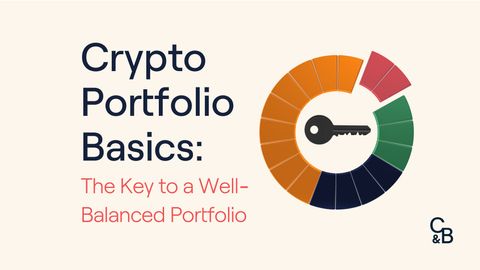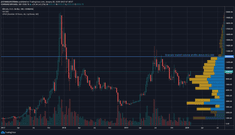There's a whole world beyond Bitcoin.
We all know about ETH and DOGE, but what about the thousands of other “alternative” coins out there? While some may have very little use and liquidity, others are pushing the boundaries of cryptocurrency, expanding on the use cases of crypto in the real world.
These coins are known as altcoins. And about 100 are created each day. To help you sift through the sea of altcoins, keep reading to learn all about these unique cryptocurrencies and their functions.
What Are Altcoins and Why do They Exist?
Altcoin, short for “alternative coin” is an umbrella term that refers to any cryptocurrency other than Bitcoin. With Bitcoin dominating around 40% of the market (by capitalisation), altcoins make up the other 60% of the total crypto market cap. It’s worth noting that Ethereum makes up a third of this number.
Although some altcoin projects share similarities with Bitcoin, many try to differentiate from the original cryptocurrency. This differentiation can be an alternative consensus mechanism, a unique use case, or a combination of both.
Some altcoins exist to solve a problem. Others are made to rally a community of investors. The levels of adoption and network effects for each project vary. Outside of meme coins, the majority of top-ranking coins aim to have wider applications.
Types of Altcoins and Their Use Cases
The 6 common types of altcoins are:
Stablecoins
Stablecoins are altcoins that attempt to offer relative price stability. Their market value is usually pegged to the value of a stable asset, like USD or gold.
Stablecoins are designed to be somewhat resistant to volatility, as the name suggests, their price is intended to remain stable, so you shouldn't see significant price variation.
Stablecoin projects claim to be backed by a reserve asset (e.g. USD), another cryptocurrency (e.g DAI), or a commodity (e.g. gold). Some stablecoins use algorithms to continually adjust their price to account for demand and supply dynamics.

DAI, USDC and USDT are examples of stablecoins. Image: Shutterstock
Through the use of algorithms, or through pegging their value on a different asset, stablecoins function more like a fiat currency within a crypto space. They are often traded at high volumes; similar to cash in a traditional market.
Meme coins
Meme coins are cryptocurrencies inspired by the social currency of the internet: memes. They could be directly inspired by a meme, like the dog-themed Dogecoin (DOGE), or centred around a community interest, like garlic bread (GRLC).
Anyone with an internet connection can make and distribute a meme. And with the right technical knowledge, anyone can create and distribute a meme coin. Every so often you’ll find celebrity-inspired coins in the market, like this Will Smith-themed coin.
Meme coins typically have a massive or unlimited supply, which accounts for their unusually low per-unit price.
While they may lack any value beyond an idea, meme coin investors get the feeling that they're involved in something greater. This community of coin evangelists help to grow or maintain interest in the asset through storytelling and social sharing.
Utility Tokens
This type of altcoin functions to provide a service within a network. They could be used as a means to gain access to a service, facilitate transactions, or earn rewards on a network. One example is XRP, a token that leverages DeFi to facilitate highly liquid trades between various fiat currencies. Another is Theta, which aims to use a peer-to-peer network to deliver high-quality video streaming services across the world. MATIC, the native token of the Polygon network has a variety of uses. It functions as a governance token, maintains network security through staking, and is used as a gas token for transaction fees.

Image: Shutterstock
Investors usually invest in utility tokens because they believe in the potential of the project itself. In a way, the token’s price value is a reflection of the value the project could provide to a wider audience.
Play-to-Earn Tokens
This type of altcoin exists within the system of a game or network of games. Users who play the game can earn cryptocurrency in the form of a native token. This can then be used to make in-game purchases (e.g. game-inspired NFTs) or trades into the wider crypto market.
Further Reading: Play-to-Earn Crypto Games
Governance Tokens
Governance tokens give investors a say in the project they are investing in. This democratised approach can help contribute to the overall decentralised nature of the project. Token owners not only use the protocol, they own it. Decisions are not made through a top-down, centralised hierarchy. A community votes together on any major platform changes.
Governance tokens usually exist as part of a DAO, or “decentralised autonomous organisation”. DAOs are not run by one central figure, rather users of the protocol abide by rules written into the code of the network, via smart contracts.
The amount of say investors have in a project is usually proportional to the size of their investment. An example would be Maker (MKR) which allows investors to vote on various DeFi protocols on the MakerDAO platform.
Security Tokens
Security tokens are the cryptocurrency equivalent to traditional stocks. They often offer equity which results in ownership or a dividend payout to investors.
Some investors are attracted to these altcoins because they share many similarities with what they already know and understand (e.g. the current stock market). But they have been subject to regulatory backlash given their murky existence between both crypto and traditional markets. An example of this would be Blockchain Capital (Bcap).
Why Are Altcoins Important?
Altcoins seek to provide alternative use cases and applications to Bitcoin. As the cryptocurrency market matures, altcoins will continue to gain real-world utility beyond what we’ve described in this article.
Altcoins are important because:
- Through the use of stablecoins, investors are able to easily access the DeFi market.
- Through the use of governance tokens, investors can have a say in the direction of the projects to which they are contributing.
- Through the use of play-to-earn tokens, communities in developing countries are finding alternative ways to the crypto market.
- Their varying use cases are helping the late majority of adopters understand that cryptocurrency is not limited to the utility of Bitcoin or Ethereum.
Deciding What to Invest in
At present there are over 19,000 cryptocurrencies in existence. Getting decision anxiety?
It doesn’t mean you’ll have to make 19,000 choices before you jump into the market. There are ways to help guide your decision making, in hopes that you land on a few choice options that will work for you.
What is the project solving? Is there utility?
A coin may be performing well right now, but is it worth your time and money? Take time to research the underlying project associated with a coin. What blockchain is it on? What are the use cases for the coin?
Do you see the coin having utility that could be valuable now or in the future? Understanding the underlying goals of the project could give insight into the potential value for investment.
Do the values of this project align with your values?
At the end of the day, you want to see your investments grow. Some might feel more inclined to put their money into causes or projects they believe in. Think about your values. Are you eco-conscious? Are there any social causes that you already support? Chances are there is a project out there that aligns with your principles.
Outside of your values, also consider your current investing habits. What is your risk appetite or profile? Do you err on the conservative side? Keep these things in mind when building your portfolio.
What is the asset’s overall ranking?
The crypto market could change overnight, a relatively unknown cryptocurrency could shoot up to the top 10 just from a tweet. Realistically, the top cryptocurrencies are ranked as such for a reason. Look at these projects and the value they are offering to investors. It may give you some insight into the types of projects you should invest in.

CoinMarketCap ranks all cryptocurrencies and provides useful information on each asset. Image: coinmarketcap.com
Read the project white paper
The white paper is a key document for all cryptocurrency projects. Without it, the wider the public will not have a thorough understanding of the project and its goals.
While reading the white paper, highlight any red flags such as: a lack of real-world utility, issues with legality, or a team that operates anonymously.
Price History
Even for a seasoned trader, it can be difficult to spot and identify historical trends. But some of the original projects (e.g. Bitcoin) have a longer history that can be leveraged in your decision making.
Liquidity
Liquidity, or the ability for an asset to be quickly converted into cash or some other asset without major price fluctuations, is something else to consider when investing. Some larger cap coins (like Bitcoin, Ethereum, or Solana) have a tendency to be more liquid than smaller cap coins.
In the case of stablecoins, their price remains relatively constant. But you may not see a considerable ROI as their value is largely dependent on external factors. They are often pegged to fiat currency (like USD) which contributes to their overall stability. They are mainly used as a highly liquid trading pair, an entry point into decentralised finance (DeFi), everyday currency, or lending and borrowing.
Volume
Volume is often used to gauge interest in a particular cryptocurrency. Higher volumes could contribute to overall higher market liquidity. When assessing this measurement for a particular coin, weigh up the volume against a select time period. Trending coins could have a high volume one day and see a drop in trading once public interest dies down.
Further Reading: How to Invest in Crypto
FAQs
Where can I buy altcoins?
Through an exchange (centralised or decentralised), or through a broker like Caleb & Brown. You may discover that certain altcoins live on different exchanges, which makes creating trading pairs extremely difficult. If you’re looking for access to multiple exchanges with institutional liquidity across a variety of cryptocurrencies, consider investing through a personal broker at Caleb & Brown.
What is the top altcoin by market cap today?
As of May 18, 2022, Ethereum is the top altcoin with a market cap of $246 billion.
What consensus mechanism do altcoins use?
Each altcoin is unique. Some may use Proof of Work (PoW), Proof of Stake (PoS), or even Proof of Capacity (PoC).
Dive Into the World of Altcoins
Altcoins are showing us how cryptocurrencies can be used and applied across a variety of circumstances. They are building upon what Bitcoin created, innovating, and iterating along the way.
Top Ten Altcoins Supported by Caleb & Brown (Ranked by Market Cap)
- Ethereum (ETH) at $246B
- Tether (USDT) at $74B
- USD Coin (USDC) at $52B
- Binance (BNB) at $49B
- XRP (XRP) at $21B
- Cardano (ADA) at $19B
- Binance USD (BUSD) at $18B
- Solana (SOL) at $18B
- Dogecoin (DOGE) at $12B
- Polkadot (DOT) at $10B
If you're ready to dive in and make your first altcoin purchase, Caleb & Brown is here to help. Trusted by over 20,000 investors across 100 countries, our dedicated team of experts works around the clock to carry out all your crypto trades. We make investing in altcoins easy, allowing you to buy, swap and sell hundreds of altcoins for one low, transparent fee per transaction.
Get set up with a personal broker today and you’ll receive a free security consultation, along with support to help you execute your first altcoin investment.
Disclaimer: This assessment does not consider your personal circumstances, and should not be construed as financial, legal or investment advice. These thoughts are ours only and should only be taken as educational by the reader. Under no circumstances do we make recommendation or assurance towards the views expressed in the blog-post. The Company disclaims all duties and liabilities, including liability for negligence, for any loss or damage which is suffered or incurred by any person acting on any information provided.






